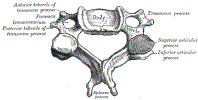Cervical Spine Fracture, C-Spine Fracture, Clay Shoveler's Fracture, Odontoid Process Fracture, Hangman's fracture, Jefferson Fracture, Cervical Wedge Compression Fracture, C1 Fracture, C2 Fracture, Cervical Teardrop Fracture, Cervical Spinous Process Fracture, Cervical Burst Fracture, Cervical Facet Dislocation, Cervical Fracture
- Anatomy
- See Cervical Spine Anatomy
- Image: Cervical Vertebrae
 Lewis (1918) Gray's Anatomy 20th ed (in public domain at Yahoo or BartleBy)
Lewis (1918) Gray's Anatomy 20th ed (in public domain at Yahoo or BartleBy)
- Three-Column Model
- Anterior column
- Anterior half of Vertebral body
- Anterior ligamentous complex
- Anterior portion of annulus fibrosus
- Anterior longitudinal ligament
- Middle column
- Posterior half of Vertebral body
- Ligaments
- Posterior portion of annulus fibrosus
- Posterior longitudinal ligament
- Posterior Column
- Facet joints (superior and inferior articular process)
- Laminae
- Spinous processes
- Posterior ligamentous complex
- Facet capsules
- Interspinous ligaments
- Anterior column
- Types
- C1 Fractures and Dislocations
- Mechanism
- Axial load or Hyperextension injuries
- May occur in diving injury into a shallow pool or being struck on the top of the head by a heavy object
- Jefferson Fracture (C1 Burst Fracture)
- Atlantooccipital Dislocation
- Types
- C2 Fractures
- Hangman's fracture
- Mechanism
- Previously most associated with hanging (MVA is most common modern mechanism)
- Unstable, hyperextension injury
- Findings
- Mechanism
- Odontoid Fractures (forced flexion or extension)
- Unstable Fracture (esp. types 2-3) secondary to multidirectional injury
- Types (Anderson and D'Alonzo Classification)
- Type 1 (Tip Fracture, most common)
- Avulsion Fracture with injury to the alar ligament
- Fracture of the top of the dens (superior, odontoid tip)
- Instability is uncommon (but evaluate with flexion and extension films)
- Managed with Cervical Collar immobilization
- Type 2 (Waist Fracture, most serious/unstable)
- Fracture at the mid-dens
- High risk for devascularization and nonunion
- Types (Grauer Classification)
- Type 2A: Nondisplaced or minimally displaced and without comminution
- Treated with external immobilization
- Type 2B: Displaced Fracture - anterosuperior to posteroinferior
- Treated with anterior odontoid screw (requires adequate bone density)
- Type 2C: Comminuted, displaced Fracture - anteroinferior to posterosuperior
- Treated with posterior stabilization
- Type 2A: Nondisplaced or minimally displaced and without comminution
- Type 3 (Base Fracture)
- Type 1 (Tip Fracture, most common)
- References
- Types
- Facet Dislocation
- Unilateral facet dislocation
- Bilateral facet dislocation
- Unstable injury
- Mechanism
- Severe hyper-flexion force to the middle and Posterior Columns
- Disrupts the anterior longutudinal ligament, intervertebral disc and posterior ligaments
- Findings
- Types (in order of increasing severity)
- Subluxed facets
- Perched facets
- Locked facets
- Types
- Wedge Compression Fracture
- Mechanism
- Hyperflexion loading of the spine (even minor forces, esp. in Osteoporosis)
- More often affects the thoracolumbar spine
- Anterior Vertebral body compression (with or without posterior compression)
- Types
- Flexion Teardrop Fracture
- Mechanism
- Flexion and compression injury (e.g. diving)
- Disrupts all supportive ligaments and the intervertebral disc
- Associated with anterior Spinal Cord Compression (Anterior Cord Syndrome)
- Fracture dislocation which is highly unstable
- References
- Flexion Teardrop Fracture (Radiopaedia)
- Types
- Translation-Rotation Fracture
- Severe, unstable injury almost always requiring Spine Surgery
- Mechanism
- Displacement of a Fracture in the horizontal plane (left-right, anterior-posterior or rotational)
- Findings
- Types
- Burst Fracture
- Mechanism
- Flexion and compression injury (e.g. diving)
- Compression of both the anterior and posterior Vertebral body height
- Most commonly affects the mid-Cervical Spine
- Comminuted, unstable Vertebral Fracture
- Disrupts anterior and middle columns
- Typically involves middle and lower Cervical Vertebrae
- Spinal Cord Injury may result from bone fragments displaced into the spinal canal
- Findings
- Vertebral height loss
- Posterior Ligamentous Complex Injury
- Types
- Spinous Process Fracture
- Mechanisms
- Direct spinous process Trauma
- Sudden deceleration
- High velocity Trauma with neck flexion
- Severe Muscle Contraction with secondary avulsion
- Clay Shoveler's Fracture (Spinous process tip avulsion)
- Imaging
- Management
- See Cervical Spine Injury
- See Cervical Spine Immobilization
-
Vertebral Fracture Stability
- Consider any cervical Vertebral Fracture unstable with the exception of those listed below
- Subaxial Injury Classification and Severity Scale (SLICS)
- Unstable Cervical Spine Fracture (Mnemonic - "Jefferson Bit Off A Hangman's Tit")
- J - Jefferson Fracture (C1 Burst Fracture, axial loading injury)
- B - Bifacet dislocation or Fracture (flexion injury)
- O - Odontoid Fracture (Types 2 and 3, flexion injury)
- A - Any Fracture-dislocation, Atlantoaxial dislocation or atlanto-occipital dislocation (flexion injury)
- H - Hangman's fracture or bilateral C2 Pedicle Fracture (posterior C2 Fracture, extension injury)
- T - Flexion Teardrop Fracture
- Stable Fractures
- References
- Dreis (2020) Crit Dec Emerg Med 34(7):3-21
- Eiff and Hatch (2018) Fracture Management for Primary Care, p. 187-96
- Ouellette and Tetreault (2015) Clinical Radiology, Medmaster, Miami, p. 42-50